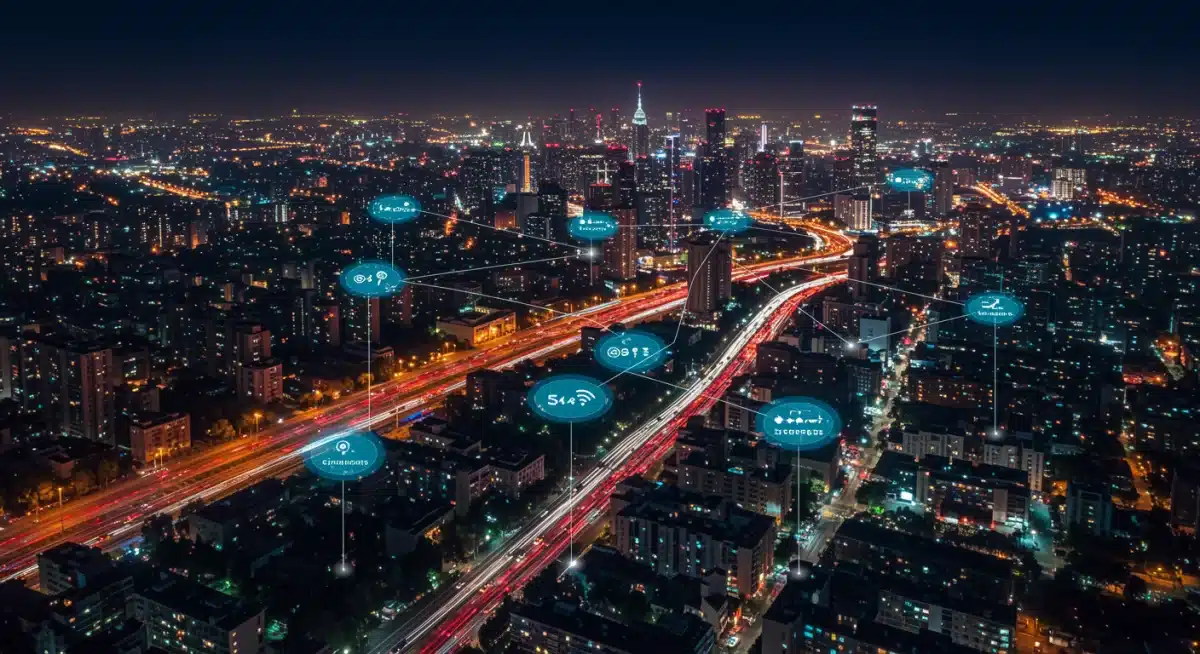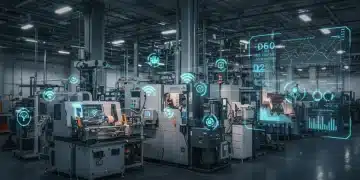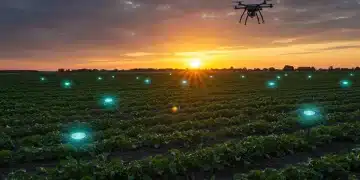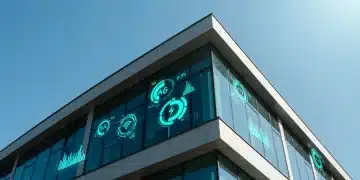IoT Sensor Technology Evolution: Smart Dust to Smart Cities in 5 Years

The evolution of IoT sensor technology, from micro-scale smart dust to comprehensive smart city networks, is rapidly transforming urban environments and connectivity, promising unprecedented integration over the next five years.
From Smart Dust to Smart Cities: The Evolution of IoT Sensor Technology Over the Next 5 Years is not merely a technological trend but a foundational shift, reshaping how we interact with our environment and each other. This transformation is currently underway, with new advancements emerging daily, promising a future where our surroundings are not just responsive but predictive, driven by an ever-expanding network of intelligent sensors.
The Dawn of Smart Dust: Miniaturization and Ubiquity
The concept of smart dust, once relegated to science fiction, is rapidly becoming a reality. These microscopic sensors, equipped with computing power, wireless communication, and energy harvesting capabilities, are designed to permeate environments, collecting data on an unprecedented scale. Their small size allows for deployment in previously inaccessible areas, offering a new dimension to data collection and environmental monitoring.
The initial focus for smart dust deployment is largely in niche applications where traditional sensors are impractical. Think of monitoring structural integrity in aging infrastructure or tracking environmental pollutants at a hyper-local level. These tiny devices promise to provide granular insights that were once impossible to obtain, laying the groundwork for a truly ubiquitous sensing network.
Key Advancements Driving Smart Dust Adoption
- Energy Harvesting: Innovations in piezoelectric and thermoelectric materials mean smart dust can power itself from ambient vibrations or temperature differences, extending operational lifespan.
- Miniaturized Communication: Ultra-low-power radio technologies enable these tiny sensors to transmit data efficiently over short distances, forming mesh networks.
- Advanced Manufacturing: Progress in micro-electro-mechanical systems (MEMS) allows for the mass production of these complex devices at diminishing costs.
As these technologies mature, the cost-effectiveness and scalability of smart dust will increase dramatically. This will open doors for broader applications, moving from specialized industrial uses to more general environmental and even personal health monitoring, acting as the nervous system of future smart environments.
Sensor Integration: Bridging the Gap to Smart Environments
Beyond individual smart dust particles, the true power lies in their integration into larger, more complex systems. The next five years will see a significant push towards seamless sensor integration, combining data from various sources to create a holistic view of an environment. This involves not just hardware compatibility but also sophisticated software platforms capable of processing and interpreting diverse data streams.
This phase is critical for moving beyond isolated data points to actionable intelligence. Imagine sensors in public spaces detecting crowd density, air quality, and noise levels simultaneously. The integration of this data allows for dynamic adjustments to urban planning, resource allocation, and emergency response, providing a foundation for truly responsive smart environments.
Challenges in Seamless Integration
- Interoperability Standards: A lack of universal standards for data formats and communication protocols remains a significant hurdle. Efforts are underway to establish common frameworks.
- Data Volume and Processing: The sheer volume of data generated by integrated sensor networks requires robust edge computing and cloud infrastructure to process in real-time.
- Security and Privacy: Ensuring the security of sensitive data and protecting individual privacy are paramount, necessitating advanced encryption and anonymization techniques.
Overcoming these challenges is essential for unlocking the full potential of integrated sensor networks. Collaborative efforts between industry, academia, and government bodies are crucial to developing the necessary standards and infrastructure for this next wave of IoT evolution.
AI and Machine Learning: Intelligence at the Edge
The massive amounts of data generated by an evolving IoT sensor network demand advanced analytical capabilities. Artificial intelligence (AI) and machine learning (ML) are becoming indispensable, moving beyond centralized cloud processing to the ‘edge’ of the network. Edge AI allows sensors to process and analyze data locally, making decisions in real-time without constant communication with a central server.
This shift to edge intelligence is a game-changer for latency-sensitive applications. For example, in smart traffic systems, sensors can use AI to optimize signal timing based on immediate traffic flow, preventing congestion before it escalates. In smart manufacturing, edge AI enables predictive maintenance, identifying potential equipment failures before they occur, minimizing downtime.
Impact of Edge AI on IoT Sensors
- Reduced Latency: Real-time decision-making is possible, crucial for critical infrastructure and autonomous systems.
- Enhanced Security: Less raw data needs to be transmitted to the cloud, reducing exposure to cyber threats.
- Optimized Bandwidth: Only processed, actionable insights are sent upstream, conserving network resources.
The integration of AI and ML directly into sensor hardware will lead to a new generation of ‘intelligent sensors’ capable of self-learning and adapting to changing conditions. This evolution transforms sensors from mere data collectors into active participants in decision-making processes, marking a significant leap in IoT capabilities.
From Smart Homes to Smart Cities: Scalable Deployments
The trajectory from individual smart devices to fully integrated smart cities represents the ultimate goal of IoT sensor evolution. What begins with smart homes, optimizing energy consumption and security, expands to smart buildings, managing utilities and occupancy, and finally culminates in smart cities, orchestrating complex urban systems.
Smart cities leverage interconnected sensor networks to manage everything from public safety and waste management to transportation and environmental quality. These systems are designed to improve efficiency, reduce costs, and enhance the quality of life for urban residents. The next five years will see pilot projects evolving into widespread deployments, particularly in densely populated areas.
Pillars of Smart City Development
- Smart Mobility: Real-time traffic monitoring, intelligent parking systems, and autonomous vehicle integration.
- Smart Utilities: Dynamic energy grids, smart water management, and optimized waste collection routes.
- Public Safety: Surveillance systems, gunshot detection, and predictive policing powered by sensor data.
The realization of truly smart cities hinges on robust, scalable, and secure IoT sensor infrastructures. As cities grapple with increasing populations and resource constraints, the intelligent management offered by advanced sensor technologies becomes not just an advantage but a necessity for sustainable urban living.

Cybersecurity and Privacy: The Evolving Landscape
As IoT sensor networks become more pervasive, the challenges of cybersecurity and privacy escalate dramatically. Each sensor endpoint represents a potential vulnerability, and the vast amount of data collected raises significant privacy concerns. Addressing these issues is paramount for public trust and the long-term viability of smart city initiatives.
The next five years will witness a concentrated effort to embed security measures at every layer of the IoT architecture, from hardware-level encryption in individual sensors to robust network security protocols. Regulatory frameworks will also evolve to provide clear guidelines on data ownership, consent, and usage, balancing innovation with individual rights.
Key Security and Privacy Strategies
- Zero-Trust Architectures: Implementing models where no device or user is inherently trusted, requiring verification at every access point.
- Blockchain for Data Integrity: Utilizing distributed ledger technology to ensure the immutability and transparency of sensor data.
- Privacy-by-Design Principles: Integrating privacy considerations into the development of IoT devices and systems from the outset.
Building resilient and trustworthy IoT ecosystems requires a multi-faceted approach, involving technological innovation, stringent regulatory oversight, and continuous public education. Without a strong foundation of security and privacy, the full potential of IoT Sensor Evolution from smart dust to smart cities cannot be realized.
The Next Five Years: Projections and Impact
Looking ahead, the next five years promise an accelerated pace of innovation in IoT sensor technology. We will see smart dust becoming more sophisticated, capable of not just sensing but also limited actuation, blurring the lines between passive data collection and active environmental interaction. This will enable more dynamic and responsive smart environments.
The integration of 5G and eventually 6G networks will provide the necessary bandwidth and low latency for massive sensor deployments, allowing for real-time data exchange across vast urban landscapes. Furthermore, advancements in AI and quantum computing will unlock new levels of data analysis, enabling predictive models that can anticipate events and optimize resource allocation with unprecedented accuracy.

Emerging Trends and Their Potential Impact
- Bio-integrated Sensors: Miniaturized sensors capable of monitoring biological processes, leading to revolutionary advancements in healthcare and personalized medicine.
- Self-healing Networks: IoT systems designed to detect and repair faults autonomously, increasing reliability and reducing maintenance costs.
- Ethical AI in IoT: Growing emphasis on developing AI algorithms for IoT that are fair, transparent, and accountable, addressing societal concerns.
The journey From Smart Dust to Smart Cities: The Evolution of IoT Sensor Technology Over the Next 5 Years will fundamentally alter urban living, industrial processes, and personal well-being. This rapid evolution demands continuous adaptation and a forward-thinking approach to harness its benefits while mitigating potential risks.
Key Aspect |
Brief Description |
|---|---|
Smart Dust |
Microscopic sensors for pervasive data collection in previously inaccessible areas. |
Sensor Integration |
Combining diverse sensor data for holistic environmental understanding and actionable intelligence. |
Edge AI |
Processing and analyzing data locally on sensors for real-time decision-making and reduced latency. |
Smart Cities |
Leveraging interconnected sensors for efficient urban management and improved quality of life. |
Frequently Asked Questions About IoT Sensor Evolution
Smart dust consists of microscopic sensors with computing and communication capabilities. In the next five years, it will enable hyper-local data collection for infrastructure monitoring, environmental tracking, and potentially personal health, making cities more responsive and data-rich.
AI and ML will empower IoT sensors with edge intelligence, allowing them to process data locally and make real-time decisions. This reduces latency, enhances security, and optimizes bandwidth, crucial for dynamic smart city applications like traffic management and predictive maintenance.
Key challenges include establishing interoperability standards for diverse sensor types, managing the enormous volume of data generated, and ensuring robust cybersecurity and user privacy. Addressing these requires collaborative industry and governmental efforts.
5G and 6G networks will provide the high bandwidth and ultra-low latency necessary for massive-scale IoT sensor deployments. This will facilitate seamless, real-time data exchange across vast urban areas, enabling more responsive and interconnected smart city services.
Widespread IoT sensor adoption raises significant ethical concerns regarding privacy, data ownership, and potential surveillance. Developing robust regulatory frameworks and implementing privacy-by-design principles are crucial to ensure responsible and ethical deployment of these technologies.
What this means
The ongoing evolution of IoT sensor technology, from smart dust to smart cities, signifies a profound transformation in how we design, manage, and experience urban environments. Over the next five years, this advancement will redefine efficiency, sustainability, and quality of life. Citizens should anticipate more responsive public services and a greater reliance on data-driven urban planning. Policymakers must proactively develop regulatory frameworks to ensure ethical deployment and data security, while businesses will find new opportunities in developing innovative sensor applications and integrated solutions.





